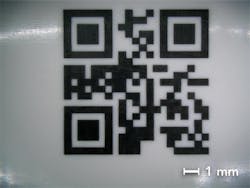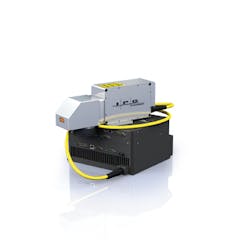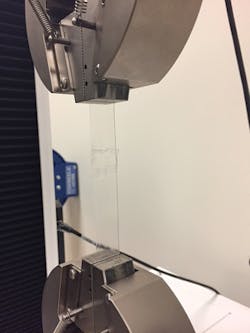Efficient fiber lasers enable innovation in medical device manufacturing
BRIAN BAIRD
Continuous advancements in fiber laser technology and their integration into compact, space-saving beam delivery systems are finding widespread applications for marking and welding of polymers for medical devices. Medical device manufacturers consider the footprint of laser marking and laser welding systems when considering adoption of next-generation laser processes, or when upgrading or replacing an existing laser process in their manufacturing facilities. Many medical devices are produced in cleanroom facilities where floor space is relatively expensive to build and maintain in comparison to more conventional manufacturing facilities.
Medical device manufacturers are increasingly evaluating and deploying pulsed ultraviolet (UV) fiber lasers emitting at 355 nm for laser marking of a broad range of polymers, and employing continuous-wave (CW) thulium-doped 2 µm fiber lasers for clear polymer-clear polymer and certain polymer-metal welding applications.
Laser marking polymers
Conventional marking of polymers has relied upon employment of infrared (IR) lasers, whether in the near-IR (1.0 µm region) or longwave-IR (LWIR; 10 µm region). While relatively low-cost and reliable, these types of lasers, which include 1.0 µm fiber and diode-pumped solid-state lasers and 10 µm carbon-dioxide (CO2) lasers, generally produce dark or gray marks on polymer materials through a thermochemical laser process referred to as carbonization. Carbonization laser marking processes often generate substantial amount of laser soot and other debris as waste products, which require well-engineered laser fume extraction to produce acceptable marks. Post-process cleaning is often additionally required to remove soot particles that adhere to the surface.
CO2 lasers are often also used in a different laser marking process referred to as laser foaming to form raised marks in hard plastics. The laser beam heats the surface, generating gas bubbles in the heated material near the surface, resulting in a raised and solidified light mark with satisfactory contrast, with respect to the unmarked surrounding material. These thermal laser marking processes are widely adopted and in production in a diverse range of industrial applications, including consumer device electronics, automotive components, and packaging.
In contrast to conventional IR polymer marking processes, UV laser marking of polymers is a photochemical marking process that depends on the much higher photon energy of these lasers in comparison to conventional near-IR or LWIR marking lasers. The incident focused UV laser light is typically absorbed in a depth region very close to the surface and produces a high-contrast mark in an efficient cold marking process. One advantage of this cold marking process is visually crisp character and pattern formation with minimal adjoining discoloration or heat-affected zones. The marks are generally subsurface and can be produced without marring component finish and/or cosmetic appearance.
The development of frequency-tripled, Q-switched diode-pumped neodymium lasers employing lithium triborate (LBO) crystals for harmonic generation in the late 1990s led to increasing applications for UV marking of polymer materials, displacing both excimer lasers and IR lasers from this market. UV lasers demonstrated their capability to mark a wide range of polymers without the use of additives, including polycarbonate (PC), acrylonitrile-butadiene-styrene (ABS), silicone, high-density polyethylene (HDPE), and polyether ether ketone (PEEK).
UV laser marking of polymer medical devices
The rapid advance of fiber laser technology has recently enabled the introduction of high-reliability pulsed UV fiber lasers with very compact form factor and suitable energy per pulse available at high pulse repetition frequencies (>100 KHz) and short nanosecond pulse widths for efficient marking of polymers.1 The well-known advantages of pulsed fiber lasers, including low cost of ownership and superior reliability, enabled displacement of heritage lamp- and diode-pumped Q-switched solid-state lasers in many market segments. These advantages are now contributing to their rapid adoption in UV laser markers, including in the marking of polymers for the medical device market. Integration of pulsed UV fiber lasers with robust galvo scanners equipped with UV f-theta scan lenses to form easy-to operate UV laser marking systems offers medical device manufacturers an attractive, ready-to-operate compact production marker suitable for their production facilities.
As an example of this industry trend, an IPG Photonics UV laser marking module (FIGURE 1), has a laser connected to an optical scanner head. The dimensions of the optical scanner head are 407 × 149 × 127 mm. Standard configurations produce 3 W average power output at 300 KHz and 355 nm with a 1.5 ns laser pulse width. The optical scanner head has a 12 mm clear aperture and a tracking delay of <0.1 ms. When equipped with a 170 mm focal length (fl) scan lens, the working distance to the workpiece is 216 mm with a 105 × 105 mm scan field and a nominal focused spot size diameter of 17 µm (1/e2 measurement). 110 and 250 mm fl scan lens options are also available.
FIGURE 1. IPG Photonics’ UV fiber laser marker module has a laser connected to an optical scanner head.
FIGURE 2 shows an optical microscope image (20x magnification) of a 2D barcode mark produced using an IPG Photonics UV laser marking module for high-quality marking of ABS used in the manufacture of medical devices. UV marking produces a light black mark using 10 µJ laser output at 200 KHz (2.0 W) and a marking speed of 1000 mm/s. Very similar marking quality can also be achieved on ABS/PC medical tubing using similar laser process parameters.
FIGURE 2. An example of UV fiber laser marking of ABS is shown.
FIGURE 3 shows microscope images (20x magnification) of very dark gray alphanumeric and 2D barcode marks produced on Lexan (polycarbonate resin thermoplastic) The marking process parameters were 10 µJ at 60 KHz (0.6 W) using a 250 mm/s marking speed.
FIGURE 3. UV fiber laser marking of alphanumerics (a) and a 2D barcode (b), both on Lexan, are shown.
Thulium fiber laser welding of polymers
The advantages of 2 µm thulium fiber laser welding of polymer-metal and polymer-polymer combinations have been recently reported.2-4 Ytterbium fiber lasers emitting with 1064–1070 nm wavelengths have been used for welding clear-to-dark polymer combinations or where special additives have been incorporated to improve absorption in one or both polymers to be welded.
2 μm fiber laser radiation is directly absorbed by many polymers, enabling clear-to-clear and other color combinations to be efficiently welded together. Clamping requirements are relaxed because of the more uniform heating achieved on both sides of the weld. Thulium fiber laser welding is typically conducted with a laser output beam coupled into a galvo scanning laser workstation with optics specified for 2 µm CW output power (generally in the range of 50 to 200 W). Weld widths are typically in the range of 0.1 to 0.5 mm.
An important emerging application for thulium fiber polymer-polymer welding is joining of medical devices. A wide range of polymers can be successfully welded using 2 µm laser output, including HDPE, LDPE, polyethylene, polycarbonate, cyclic olefin copolymer (COC), and polyurethanes, such as Tecothane. These are widely used in microfluidic devices, catheters, general-purpose tubing, hospital materials, and short-term implants.
Recent shear testing of lap-welded polymer samples has demonstrated failure loads comparable to the measured shear strength of native, unwelded material (FIGURE 4).
FIGURE 4. A pull test of a clear-to-clear lap weld of 0.02-in.-thick Tecothane is shown.
Advances in fiber laser technology continue to power new applications. Collectively, UV pulsed fiber lasers and
2 µm thulium fiber lasers are increasing the adoption of fiber lasers in the manufacture of polymer medical devices, and motivating development of novel applications and beam delivery technology in this market segment. ✺
ACKNOWLEDGEMENTS
Lexan is a registered trademark of Sabic Global Technologies and Tecothane is a trademark of Lubrizol Advanced Materials.
REFERENCES
1. B. Baird, “Nanosecond and picosecond laser marking of medical devices,” International Medical Devices Conference and EXPO 2018 Processes for Device Manufacturing.
2. B. Baird, “Welding polymer tubing and welding polymer tubing directly to metals using fiber lasers,” Medical Tubing Conference 2017.
3. V. Kancharla, M. Mendes, M. Grupp, and B. Baird, “Recent advances in fiber laser welding,” Industrial Laser Solutions, 33, 3, 11–16 (May/June 2018).
4. L. Gomez, “Laser welding of medical device polymers,” International Medical Devices Conference and EXPO 2018 Processes for Device Manufacturing.
BRIAN BAIRD ([email protected]) is senior applications engineering manager at IPG Photonics, Santa Clara, CA; www.ipgphotonics.com.




